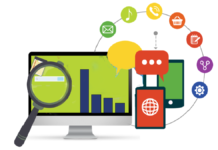TRADITIONAL ECONOMY VS DIGITAL ECONOMY
The digital economy refers to economic activity that uses electronic communication and digital technologies to provide goods and services. The main building blocks of the digital economy are
- The internet. This enables firms to offer goods for sale and enables consumers to browse for goods that they need.
- Digital automation. Firms can use the processing power of computers to make decisions on output, prices and how to reach consumers.
- Digital payments – credit cards, Apple Pay, Google pay, bitcoin, bank transfer. A digital economy is moving us towards a cashless society.
- Automation. Increasingly the digital economy relies on AI, mass use of electronic data and automated technology
- Social media. To a lesser extent, social media is an aspect of the digital economy. With individuals using it share recommendations about business.
- E-mail. Electronic communication enables very cheap, instantaneous communication across the world. It can be used to send information and requests very quickly.
|
Traditional economy |
Digital economy |
|
Factories |
Data centres/ Cloud computing |
|
High street shops |
Internet |
|
Newspaper ads/word of mouth |
Social media reviews |
|
Transportation |
E-sales – digital downloads |
|
Banks and cash points |
E-Banking |
|
School/textbooks |
E-learning, e-books |
|
9-5 commute |
Working from home |
|
Physical assets |
Google rankings / brand image |
|
Construction |
Website development |
|
Real estate |
Domain ownership |
|
Cash – cheque payment |
e-payment, cashless society |
|
Labour and capital |
Automation and AI. |
The traditional economy is based on physical shops, goods and cash payments. Over time, the traditional economy has adopted aspects of the digital economy, e.g. traditional firms taking debit cards, then selling online. As the digital economy evolved, some firms missed out on having a physical shop altogether, and selling straight from an e-commerce site, delivered to consumers’ homes. Some digital services now have no physical goods. For example, Netflix and Spotify do not need to use any physical goods but has everything streamed through the internet.
Examples of the digital economy
- Airing – This enables tourists to book online. It has also made it possible for individual households to let their house/room to tourists. Before the digital economy it was not practical.
- Amazon market place/EBay.
- Netflix – This enables consumers to purchase TV-series and films over the internet, without need for any physical good.
- E-commerce site – E.g. Economics help, selling e-books for economics revision.

Advantages of the digital economy in the world
- Greater information. The internet has enabled consumers to have greater information and choice. For example, it makes it easier to compare prices between firms. It also brings information to a person’s fingertips. This is particularly important for tourists going on holiday. Before the digital economy, it might not be possible to find the prices of hotels and bus timetables.
- Saves time. Before if you needed office supplies, you would have to make a journey into town and purchase. Now, you can make an order over the internet and it will arrive the next day. This saves business labor costs.
- Reduced costs. Firms can save on renting expensive buildings by running most of business through the internet. A digital economy enables firms to cut out an aspect of the retail chain and send personalized goods direct from factory or warehouse to people’s goods, rather than through shops. This enables lower costs and lower prices.
- Personalization. A digital economy allows greater personalization than would be possible under traditional economy. For example, a traditional shop would only have room to stock a certain number of colors and sizes, but with the digital economy, a consumer can choose any preference and then the product can be custom-built e.g. 3D printer. For example, custom clothes that have particular sizes and colors to match individual preferences.
- Lower barriers to entry. In some markets, aspects of the digital economy make it easier for new firms to enter. If an entrepreneur has an innovative idea that catches on, they can create a new product which challenges traditional firms. The digital economy has brought many new services which were inconceivable before, such as online home deliveries for grocery to dating apps.
- Creates significant data which can give new insights. The mass production of data can help inform governments and charities about what is happening in the economy. For example, in tracking of COVID-19 spread, the use of an app on mobile phones may indicate where local hotspots emerge.
- Benefits for developing world. The digital economy is opening up opportunities for the developing world. For example, computer programmers in India can easily underbid western counterparts, leading to new job opportunities and higher income in India.
Enables people to work from home. The digital economy has been a huge asset during the COVID lockdown. Without digital technologies, the decline in economic activity would have been even greater. The digital economy gives greater scope for people working from home and having greater flexibility in their hours (which may suit parents with children). Working from home can reduce contact and spread of a virus. It can also help reduce traffic congestion and pollution.




















This is very well summarised and explained. Thanks a lot.